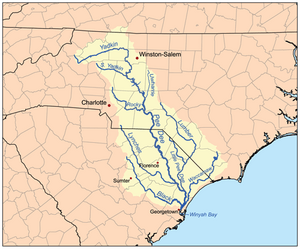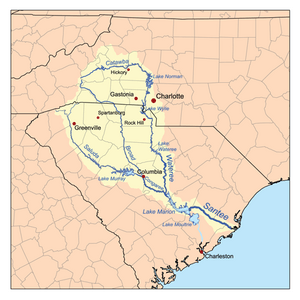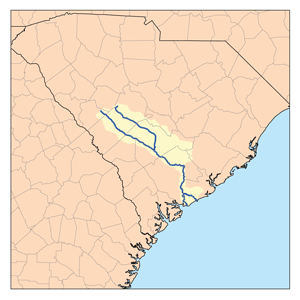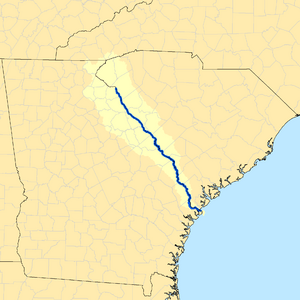List of rivers of South Carolina facts for kids
South Carolina is a beautiful state with many important rivers. These rivers flow across the land, bringing water to plants, animals, and people. They also play a big role in the state's history and how people live today. This article will tell you about the main rivers in South Carolina and where their waters go.
Contents
Rivers and Their Basins
Imagine a giant bathtub, but instead of holding water, it collects all the rain and snow that falls over a large area. This area is called a drainage basin (or watershed). All the water in a basin eventually flows into one main river or lake, and then usually out to the ocean. In South Carolina, all rivers eventually flow into the Atlantic Ocean.
Here are the main river basins in South Carolina, listed from north to south. Smaller rivers that flow into a larger one are listed underneath.
Pee Dee River Basin
The Pee Dee River system is one of the largest in the state. It starts far away in North Carolina as the Yadkin River. When it enters South Carolina, it becomes the Pee Dee River. This river is very important for the eastern part of the state.
- Little River (Horry County)
- Pee Dee River
- Sampit River
- Black River
- Black Mingo Creek
- Pocotaligo River (a tributary of the Black River)
- Little Pee Dee River
- Lumber River
- Lynches River
- Little River (a tributary of the Lynches River)
- Jeffries Creek
- Black Creek (a tributary of the Pee Dee River)
Santee River Basin
The Santee River is formed when two other big rivers, the Wateree and the Congaree, join together. It's one of the longest rivers in the state and splits into the North Santee and South Santee rivers before reaching the ocean.
- Santee River (The North Santee River and South Santee River are branches of the main river)
- Little River (a tributary of the Santee River)
- Wateree River
- Catawba River
- Fishing Creek (a tributary of the Catawba River)
- Catawba River
- Congaree River
- Dead River
- Old Dead River
- Broad River (This is the northern Broad River)
- Little River (a tributary of the Broad River)
- Enoree River
- Tyger River
* Fairforest Creek * North Tyger River ** Middle Tyger River * South Tyger River
* Little Sandy River (a tributary of the Sandy River)
* Lawsons Fork Creek * North Pacolet River * South Pacolet River
-
-
- Saluda River
- Little Saluda River
- Bush River
- Little River (a tributary of the Saluda River)
- Reedy River
- North Saluda River
- Middle Saluda River
- South Saluda River
- Saluda River
-
* Oolenoy River
Charleston Area Rivers
Several rivers flow into Charleston Harbor, a busy port city. These rivers are important for shipping and for the natural beauty of the coast.
- Wando River
- Cooper River
- Back River (a branch of the Cooper River)
- Ashley River
- Stono River
- Kiawah River
Edisto River Basin
The Edisto River is special because it's one of the longest free-flowing blackwater rivers in North America. "Blackwater" means its water looks dark because of decaying plants, but it's very clean.
- Edisto River (The North Edisto River and South Edisto River are branches of the main river)
- Four Holes Swamp
- North Fork Edisto River
- Bull Swamp Creek
- South Fork Edisto River
- Little River (a tributary of the Edisto River)
- Ashepoo River
- Combahee River
- Coosaw River
- Morgan River (SC)
- Story River
- Beaufort River
- Broad River (This is the southern Broad River)
- Colleton River
- Pocotaligo River (a tributary of the Broad River)
- Coosawhatchie River
- Tulifiny River
- May River
- New River
- Wright River
Savannah River Basin
The Savannah River forms a natural border between South Carolina and Georgia. It's a very important river for both states, providing water and power.
- Savannah River
- Stevens Creek
- Little River
- Rocky River
- Seneca River
- Keowee River
- Little River (a tributary of the Keowee River)
- Keowee River
* Flat Shoals River
* Thompson River
-
- Tugaloo River
- Chauga River
- Chattooga River
- East Fork Chattooga River
- Tugaloo River
See also






